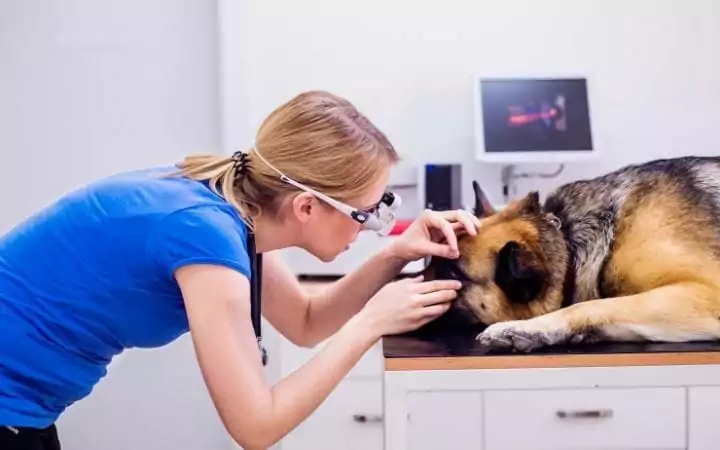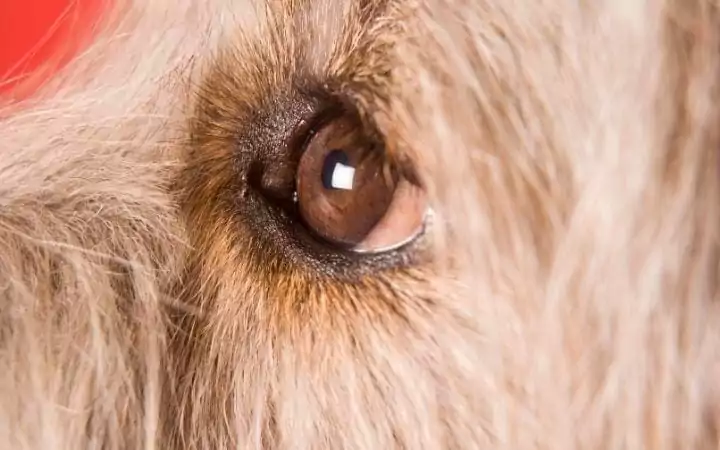When you hear the term conjunctivitis, you may have flashbacks of when you or your friend had it a few months ago. Something that we all can agree on is that having pink eye is so uncomfortable (and itchy!)
As a dog owner, you might be wondering “Can dogs get pink eye?” The answer is “yes”. We know, such a shame!
In this blog post, we will tell you everything you need to know about pink eye in dogs, including some tips to prevent it. Let’s get right into it.

What Is Conjunctivitis (aka Pink Eye)?
It is important to define the affected area by conjunctivitis (conjunctiva) to understand this condition. The conjunctiva is the tissue that covers the eyeball and surrounds the third eyelid. The primary functions of the conjunctiva are to protect the eye, create eye movement, and produce tears. A healthy conjunctiva in dogs is not easily noticeable.
When a dog has conjunctivitis, the conjunctiva becomes red and swollen. It can affect one or both eyes.

How do You Know if Your Dog Has Pink Eye? – Symptoms
Conjunctivitis in dogs can be easy to control. However, some underlying causes can be more severe and will need monitoring and additional treatment. It is recommendable to take your dog to the vet if you see any of the following symptoms:
- Redness and inflammation of the conjunctiva with eyes partially closed
- Pawing at the eye caused by discomfort
- Eyelids sticking together
- Discharge from the eyes. There are different types of conjunctivitis, according to the kind of discharge:
Serous Conjunctivitis: Clear and watery discharge.
Mucoid conjunctivitis: Greeny-yellow mucus-like discharge.
Purulent conjunctivitis: Pus discharge which can sometimes create crust in the eyelids.

How Can Dogs Contract Pink Eye?
The causes of conjunctivitis in dogs are numerous. It is often a secondary condition, which means that it arises as a result of other diseases or injuries. Primary infectious (root cause) conjunctivitis is unusual in dogs. Viral and bacterial infections can also be causes of pink eye in dogs. Below, you can find a list of some other causes of conjunctivitis:
- Allergens and irritants (allergic conjunctivitis) such as dust, pollen, cosmetics, and drugs. Allergic conjunctivitis usually is serous.
- Foreign bodies, including grass and debris. Foreign objects in the dog’s eye are a common cause of conjunctivitis in one eye.
- Eye traumas, for example, a scratch or bite from another animal.
- Other eye conditions such as dry eye ( medical term: keratoconjunctivitis sicca), which is the inadequate production of tears and it is usually due to a disease of the immune system. Poor lubrication of the eye can affect the eye surface and result in conjunctivitis. Other eye conditions are canine glaucoma (a disease where there is an increase of the pressure within the eye) and ulcerative keratitis (inflammation of the cornea).
- Viral conjunctivitis is a result of an upper respiratory infection. Conjunctivitis in dogs can also be a secondary condition of canine herpesvirus and canine distemper virus. Unlike the causes above, viral conjunctivitis can be contagious.
- Bacterial infections such as staph infections (Staphylococcus bacteria) and Streptococcal infections (Streptococcus bacteria). These bacteria are the common cause of conjunctivitis in puppies (neonatal ophthalmia or conjunctivitis).
- Presence of plasma cells (plasma-cells conjunctivitis or lymphoplasmacytic infiltration). Common in German Shepherds.
Some dogs may be more prone to conjunctivitis and eye problems because of the form of their eyes – for example, dogs with loose skin like St. Bernard have a “diamond” eye form and the eyelids can turn inwards which may irritate the eye due to the constant rubbing of the hair against the eye.
Your vet will perform clinical examinations and further diagnostic tests to determine the underlying cause of conjunctivitis in your dog.

Diagnosing Conjunctivitis in Dogs
The goal of the diagnosis procedure is to get to the root cause of the inflammation of the conjunctiva.
The first parts of the diagnosis process consist of a regular clinical examination to check the overall condition of your pet and take the medical history (previous injury to the eyes, other illnesses, medications).
Then your veterinarian will do a full ophthalmic examination to rule out diseases and find the cause. The examination may involve:
- Checking the production of tears with a simple Schirmer tear production test.
- Swabbing the conjunctiva for any sign of infection.
- Blood tests.
- Taking a sample of the conjunctiva to examine the cells by scraping it gently with a swab or spatula.
- Spreading fluorescein stain on the surface of the eye to notice any signs of foreign materials, ulcers (ulcerative keratitis), and trauma.
Treating Conjunctivitis in Dogs
When your veterinarian determines the underlying cause, they will perform or prescribe treatment depending on the diagnosis. For example, if the cause of pink eye in your dog is a foreign material, your vet will remove it under anesthesia.
Or if your dog has a bacterial infection, she may prescribe an antibiotic in injection or tablet form. If the cause of conjunctivitis in your pooch is an allergic or irritant reaction, your vet may prescribe an antihistamine along with a course of other medications.
In most cases, the treatment of conjunctivitis in dogs contains the application of eye drops or ointments. Make sure to wash your hands and clean the eye before dispensing any ointment or eye drops if there is a lot of discharge.
Applying solutions to your canine friend’s eye may be challenging; here is a video with a step-by-step guide on how to do it without putting your dog under too much stress.
If there is an eye illness behind the reason for conjunctivitis in your dog, your veterinarian will treat it and make an actionable plan.
Sometimes, your vet may ask you to apply a cold compress in your dog’s eye to help reduce swelling. If the eye is too dry due to another condition, your vet may prescribe tear stimulation.
How to Prevent Canine Pink Eye?
As a pet parent, we know how much you care about your furry friend! There are some things you can do to practice preventive care and decrease the change of conjunctivitis in your pet.
- To prevent allergic conjunctivitis, it would be a good idea to identify the allergen and keep your house as clean as you can to avoid exposure to dust.
- Maintain your dog well-groomed and keep an eye for any foreign material around your dog’s eye after playtime.
- Frequently disinfecting and washing your pooch’s bedding and toys to decrease the chance of contact with microorganisms.
- Regular check-ups with your vet can help with an early diagnosis of any condition.
- Adequate diet and exercise can aid your dog’s immune system to fight many illnesses.
Summary
Even though conjunctivitis may not be a life-threatening condition, it is essential to determine the cause of this condition as some of them may be serious. If you suspect that your dog has conjunctivitis based on the symptoms indicated in this article, it is best to take your dog to the vet for diagnosis and management.
You can get your dog on the road to recovery very fast with early diagnosis and following your vet’s advice on treatment. It is essential to stay consistent with treatment and monitor your pooch’s progress, and if in any doubt, call your vet.
We know you want to see your dog happy and healthy in all aspects. If you are looking for tips to improve your dog’s health, check out this infographic.

